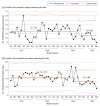Pediatric Ventilator-Associated Events Before and After a Multicenter Quality Improvement Initiative
- PMID: 38060226
- PMCID: PMC10704274
- DOI: 10.1001/jamanetworkopen.2023.46545
Pediatric Ventilator-Associated Events Before and After a Multicenter Quality Improvement Initiative
Abstract
Importance: Pediatric ventilator-associated events (PedVAEs, defined as a sustained worsening in oxygenation after a baseline period of stability or improvement) are useful for surveillance of complications from mechanical ventilation. It is unclear whether interventions to mitigate known risk factors can reduce PedVAE rates.
Objective: To assess whether adherence to 1 or more test factors in a quality improvement bundle was associated with a reduction in PedVAE rates.
Design, setting, and participants: This multicenter quality improvement study obtained data from 2017 to 2020 for patients who were mechanically ventilated and cared for in neonatal, pediatric, and cardiac intensive care units (ICUs). These ICUs were located in 95 hospitals participating in the Children's Hospitals' Solutions for Patient Safety (SPS) network in North America. Data analyses were performed between September 2021 and April 2023.
Intervention: A quality improvement bundle consisted of 3 test factors: multidisciplinary apparent cause analysis, daily discussion of extubation readiness, and daily discussion of fluid balance goals. This bundle was distributed to a subgroup of hospitals that volunteered to participate in a collaborative PedVAE prevention initiative under the SPS network guidance in July 2018.
Main outcomes and measures: Each SPS network hospital submitted monthly PedVAE rates from January 1, 2017, to May 31, 2020, and test factor data were submitted from July 1, 2018, to May 31, 2020. Analyses focused on hospitals that reliably submitted PedVAE rate data, defined as outcomes data submission through May 31, 2020, for at least 80% of the baseline and postbaseline periods.
Results: Of the 95 hospitals in the SPS network that reported PedVAE data, 21 were grouped in the Pioneer cohort and 74 in the non-Pioneer cohort. Only 12 hospitals (57%) from the 21 Pioneer hospitals and 33 (45%) from the 74 non-Pioneer hospitals were considered to be reliable reporters of outcome data. Among the 12 hospitals, the PedVAE rate decreased from 1.9 to 1.4 events per 1000 ventilator days (absolute rate difference, -0.6; 95% CI, -0.5 to -0.7; P < .001). No significant change in the PedVAE rate was seen among the 33 hospitals that reliably submitted PedVAE rates but did not implement the bundle. Of the 12 hospitals, 3 that reliably performed daily discussion of extubation readiness had a decrease in PedVAE rate from 2.6 to 1.2 events per 1000 ventilator days (absolute rate difference, -1.4; 95% CI, -1.0 to -1.7; P < .001), whereas the other 9 hospitals that did not implement this discussion did not have a decrease.
Conclusions and relevance: This study found that a multicenter quality improvement intervention targeting PedVAE risk factors was associated with a substantial reduction in the rate of PedVAEs in hospital ICUs. The findings suggest that ICU teams seeking to reduce PedVAEs incorporate daily discussion of extubation readiness during morning rounds.
Conflict of interest statement
Figures



References
Publication types
MeSH terms
LinkOut - more resources
Full Text Sources
Miscellaneous

